Moroccan Elephant Fish Recipe
|
|
SpotX Wild Foods Recipe from Petra Moorby
|
Elephant Fish
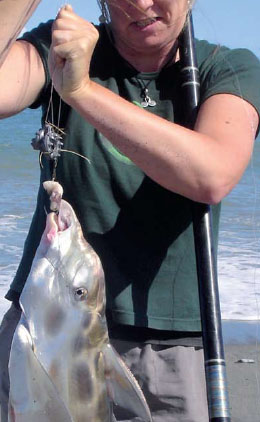 While it might not win any beauty pageants, the elephant fish is recognised in southern parts of New Zealand as a good eating specimen.
While it might not win any beauty pageants, the elephant fish is recognised in southern parts of New Zealand as a good eating specimen.
It features a large, fleshy, cartilaginous trunk that protrudes from the snout – and together with large winglike pectoral fins – combines to give the fish a rather grotesque deformed appearance rather like Quasimodo. The snout has a useful purpose, being used to root out crabs and shellfish from muddy or sandy bottoms. When handling the fish you need to be aware of the large, sharp folding spine that forms part of the dorsal fin.
Elephant fish are closely related to sharks, having a backbone of gristle rather than a skeleton. It is not surprising that the flesh tastes a bit like lemon fish (rig or dogfish) and is popular for fish and chips, as the firm flesh holds together well and you get two boneless fillets when you prepare it for the table. It is sold in the fish shops as silverfish and silver trumpeter.
Elephant fish is caught commercially by trawlers, but between October and late summer it comes within reach of surfcasters and boaties fishing inshore, sheltered waters such as Wellington Harbour.


 If you are a member of the Wellington land-based fishing fraternity, blue moki is probably the species held in highest esteem. Blue moki fishing spots are highly regarded and Wellington Surfcasting and Angling Club members guard theirs as though their lives depended on it.
If you are a member of the Wellington land-based fishing fraternity, blue moki is probably the species held in highest esteem. Blue moki fishing spots are highly regarded and Wellington Surfcasting and Angling Club members guard theirs as though their lives depended on it. 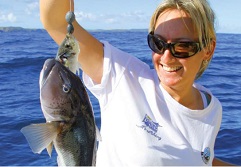 Blue cod is to Mainlanders what snapper is to their North Island counterparts.
Blue cod is to Mainlanders what snapper is to their North Island counterparts. 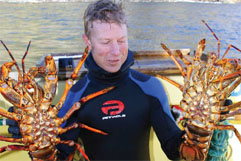
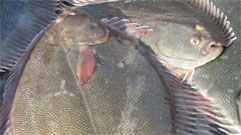 The name ‘flatfish’ covers a number of species in general terms, including yellow-bellied flounder, dabs and soles. Call them what you like; they are all good eating fish, with the yellow-bellied flounder being the culinary pick of the bunch.
The name ‘flatfish’ covers a number of species in general terms, including yellow-bellied flounder, dabs and soles. Call them what you like; they are all good eating fish, with the yellow-bellied flounder being the culinary pick of the bunch.  When you are fishing in deep water for more desirable species such as hapuku and bass, those tentative bites you sometimes feel are quite often gemfish. Having hauled these fish out of the depths, you might be quite disappointed, but gemfish can make for a tasty meal if prepared properly.
When you are fishing in deep water for more desirable species such as hapuku and bass, those tentative bites you sometimes feel are quite often gemfish. Having hauled these fish out of the depths, you might be quite disappointed, but gemfish can make for a tasty meal if prepared properly. ‘Carrots’, ‘grunters’, or just plain old gurnard, this species was one of the piscatorial under-achievers in the culinary world for many years.
‘Carrots’, ‘grunters’, or just plain old gurnard, this species was one of the piscatorial under-achievers in the culinary world for many years. _bass_and_Bluenose.jpg) These three popular recreational species are quite often incorrectly lumped together, under the heading ‘hapuku’.
These three popular recreational species are quite often incorrectly lumped together, under the heading ‘hapuku’.  Ask most anglers to list their ‘top five’ table fish and it is a safe bet the majority will include john dory.
Ask most anglers to list their ‘top five’ table fish and it is a safe bet the majority will include john dory. 
 In more recent times kingfish has almost become a ‘recreationalonly species’. The Total Allowable Commercial Catch is spread widely, making it more of a by-catch than a species the fishing industry targets specifically.
In more recent times kingfish has almost become a ‘recreationalonly species’. The Total Allowable Commercial Catch is spread widely, making it more of a by-catch than a species the fishing industry targets specifically.  The various species of trout were introduced, but unlike rabbits, stoats, wallabies, possums, goats and the like, trout has not turned around and bitten us in the backside.
The various species of trout were introduced, but unlike rabbits, stoats, wallabies, possums, goats and the like, trout has not turned around and bitten us in the backside.  Bill Hohepa described maomao as the muttonbird (sooty shearwater) of the underwater world. Anyone who has tried to strayline down a berley trail over foul ground will appreciate Bill’s sentiments.
Bill Hohepa described maomao as the muttonbird (sooty shearwater) of the underwater world. Anyone who has tried to strayline down a berley trail over foul ground will appreciate Bill’s sentiments. Smoking is the most practical way of sharing your prized striped marlin catch with friends and family.
Smoking is the most practical way of sharing your prized striped marlin catch with friends and family.  While many people think that grey mullet is best used as bait, for snapper in particular, it tantalises human taste buds as smoked fish.
While many people think that grey mullet is best used as bait, for snapper in particular, it tantalises human taste buds as smoked fish.  Octopus is not an uncommon catch for recreational anglers.
Octopus is not an uncommon catch for recreational anglers.  While most people regard fresh piper (garfish) as one of the ‘ultimate’ snapper and kingfish baits, those in the know also appreciate this ‘upside-down-marlin’ for its table qualities.
While most people regard fresh piper (garfish) as one of the ‘ultimate’ snapper and kingfish baits, those in the know also appreciate this ‘upside-down-marlin’ for its table qualities.  While porae are not the most sought-after fish, they have a white, moist flesh that has good Omega 3 levels and is suited to most cooking methods. They are closely related to tarakihi and moki.
While porae are not the most sought-after fish, they have a white, moist flesh that has good Omega 3 levels and is suited to most cooking methods. They are closely related to tarakihi and moki.  Ever wondered where the name ‘shark and tatties’ originated? The answer is simple: for many years takeaway shops used ‘lemon fish’ or ‘doggie shark’, the common names for spotted dogfish or rig, as the species of choice for their fish and chips.
Ever wondered where the name ‘shark and tatties’ originated? The answer is simple: for many years takeaway shops used ‘lemon fish’ or ‘doggie shark’, the common names for spotted dogfish or rig, as the species of choice for their fish and chips.  Most of the cooking ‘rules’ that apply to trout can be adapted for salmon and vice-versa.
Most of the cooking ‘rules’ that apply to trout can be adapted for salmon and vice-versa. 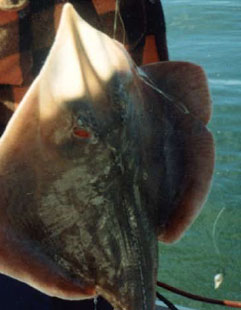 The stingray has earned its bad reputation from the sharp and often poisonous sting on its tail. But in thousands of underwater encounters, the animal has never threatened me. Here in New Zealand we know three species of stingray: the short-tailed ray, the long-tailed ray and the eagle ray. Stingrays have a unique body design, as they fly through the water rather like birds in the sky. Rays are cartilaginous fishes like sharks and do not have swim bladders to adjust their buoyancy. As a result their archenemy, the orca, doesn’t find it easy to locate them using sonar. Furthermore, rays are adept at burrowing into the sand, with only a casual flick of their wings.
The stingray has earned its bad reputation from the sharp and often poisonous sting on its tail. But in thousands of underwater encounters, the animal has never threatened me. Here in New Zealand we know three species of stingray: the short-tailed ray, the long-tailed ray and the eagle ray. Stingrays have a unique body design, as they fly through the water rather like birds in the sky. Rays are cartilaginous fishes like sharks and do not have swim bladders to adjust their buoyancy. As a result their archenemy, the orca, doesn’t find it easy to locate them using sonar. Furthermore, rays are adept at burrowing into the sand, with only a casual flick of their wings.  As we become more familiar with Asian cuisine, the status of squid, or calamari, has grown from being good only as bait to a respected and enjoyed table fish.
As we become more familiar with Asian cuisine, the status of squid, or calamari, has grown from being good only as bait to a respected and enjoyed table fish.  Tarakihi is a common species found right around New Zealand. They are a popular eating fish, being readily available to recreational and commercial fishers alike.
Tarakihi is a common species found right around New Zealand. They are a popular eating fish, being readily available to recreational and commercial fishers alike.  Like kahawai, trevally was for many years considered only good as bait. The flesh is relatively dark and quite oily, making it ideal for smoking. Filleted, the fish has a strong flavour that works well in pasta and other dishes where sauces might overpower the more delicate taste of other species. Trevally is also excellent grilled or barbecued as steaks, fillets or cooked whole. Where possible, leave the skin on – it helps keep the fish together and the fat under the skin keeps the flesh moist.
Like kahawai, trevally was for many years considered only good as bait. The flesh is relatively dark and quite oily, making it ideal for smoking. Filleted, the fish has a strong flavour that works well in pasta and other dishes where sauces might overpower the more delicate taste of other species. Trevally is also excellent grilled or barbecued as steaks, fillets or cooked whole. Where possible, leave the skin on – it helps keep the fish together and the fat under the skin keeps the flesh moist. 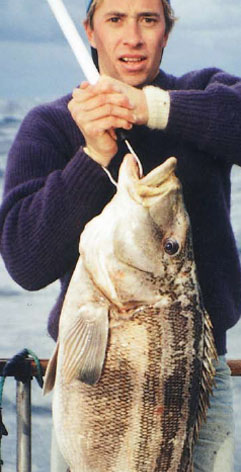 Trumpeter, a relative of the blue moki, is widely spread geographically.
Trumpeter, a relative of the blue moki, is widely spread geographically. 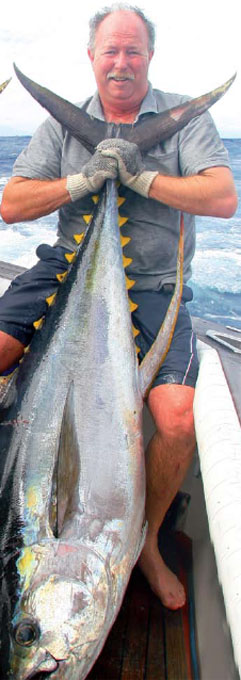 Many nations put a huge price on the meat of a number of tuna species, especially big-eye, yellowfin and bluefin tunas.
Many nations put a huge price on the meat of a number of tuna species, especially big-eye, yellowfin and bluefin tunas.  Warehou, often nicknamed ‘Hou’ by Wellington anglers who seem to have a colloquial name for every species in their waters, are widely distributed around the coastline of the South Island as well as the southern North Island.
Warehou, often nicknamed ‘Hou’ by Wellington anglers who seem to have a colloquial name for every species in their waters, are widely distributed around the coastline of the South Island as well as the southern North Island.  One of New Zealand’s true delicacies, whitebait’s subtle taste is hard to put into words, but the price it demands in the shops, topping $100 a kilo at times, is testimony to its popularity among gourmets.
One of New Zealand’s true delicacies, whitebait’s subtle taste is hard to put into words, but the price it demands in the shops, topping $100 a kilo at times, is testimony to its popularity among gourmets.  Canada geese were introduced from North America in 1876 for recreational hunting, but did not get established until 1905 when 50 birds were brought into the country and liberated in a number of different regions. The birds flourished in the South Island but had died out in the North Island by the 1930s.
Canada geese were introduced from North America in 1876 for recreational hunting, but did not get established until 1905 when 50 birds were brought into the country and liberated in a number of different regions. The birds flourished in the South Island but had died out in the North Island by the 1930s.  Hunting duck is one of those Kiwi activities steeped in tradition, especially in rural communities.
Hunting duck is one of those Kiwi activities steeped in tradition, especially in rural communities.  The muttonbird (shearwater chicks – usually but not exclusively sooty shearwaters) is a native of New Zealand: the Maori call it titi and it has been a prized delicacy for many generations.
The muttonbird (shearwater chicks – usually but not exclusively sooty shearwaters) is a native of New Zealand: the Maori call it titi and it has been a prized delicacy for many generations.  Pheasants were introduced into New Zealand as a game bird for recreational hunters back in 1842; however, they did not really establish themselves until 1865 when successful breeding by the Canterbury Acclimatisation Society prompted the importation of more birds. Numbers increased and spread until the 1900s, when predators and competition for food from smaller imported birds was blamed for a drop in pheasant numbers. Breeding by the Acclimatisation Societies throughout New Zealand, combined with the breaking-in of farmland and careful husbandry by the now Fish & Game Councils, has since seen the birds flourish.
Pheasants were introduced into New Zealand as a game bird for recreational hunters back in 1842; however, they did not really establish themselves until 1865 when successful breeding by the Canterbury Acclimatisation Society prompted the importation of more birds. Numbers increased and spread until the 1900s, when predators and competition for food from smaller imported birds was blamed for a drop in pheasant numbers. Breeding by the Acclimatisation Societies throughout New Zealand, combined with the breaking-in of farmland and careful husbandry by the now Fish & Game Councils, has since seen the birds flourish. Pukeko is the Maori name for this colourful and cheeky bird. It means ‘swamp hen’, as the same bird is known in Australia. It is believed to have settled here 1,000 years ago, although there is only fossil proof of its existence here going back 400 years or so.
Pukeko is the Maori name for this colourful and cheeky bird. It means ‘swamp hen’, as the same bird is known in Australia. It is believed to have settled here 1,000 years ago, although there is only fossil proof of its existence here going back 400 years or so.  We have two species of quail in New Zealand, the bobwhite quail and the California quail, with the latter the most common.
We have two species of quail in New Zealand, the bobwhite quail and the California quail, with the latter the most common.  There are seven species of swans in the world, all pure white, except for the Australian black swan and the South American black-necked swan. The black swan is an Australian bird that flew to New Zealand around 1860 at the same time as acclimatization societies were releasing it as a game bird, resulting in an explosion of swan numbers.
There are seven species of swans in the world, all pure white, except for the Australian black swan and the South American black-necked swan. The black swan is an Australian bird that flew to New Zealand around 1860 at the same time as acclimatization societies were releasing it as a game bird, resulting in an explosion of swan numbers.  Turkeys were introduced to New Zealand in the 1890s and have since evolved into semi-domestic animals. Most farms around New Zealand have a mob of turkeys that roam wild within their own preset boundaries. While turkeys can fly, they prefer to travel by foot and can be quite tough as a result; especially when compared with the shop-bought turkey most of us are used to.
Turkeys were introduced to New Zealand in the 1890s and have since evolved into semi-domestic animals. Most farms around New Zealand have a mob of turkeys that roam wild within their own preset boundaries. While turkeys can fly, they prefer to travel by foot and can be quite tough as a result; especially when compared with the shop-bought turkey most of us are used to. A native to central and southern Europe and a member of the antelope family, chamois were introduced into New Zealand in 1907.
A native to central and southern Europe and a member of the antelope family, chamois were introduced into New Zealand in 1907.  Like most of our game, deer were introduced to New Zealand as both a source of food and sport.
Like most of our game, deer were introduced to New Zealand as both a source of food and sport.  Liberated in 1773 by Captain Cook in Queen Charlotte Sound, goats have long been a source of meat for Kiwis.
Liberated in 1773 by Captain Cook in Queen Charlotte Sound, goats have long been a source of meat for Kiwis.  Captain James Cook first released rabbits in New Zealand in 1777 as a source of meat and fur. With limited habitat they spread slowly until farmers started to clear the land. As the extent of suitable habitat expanded, so did the rabbit population, and by 1890 they were present throughout most of the country.
Captain James Cook first released rabbits in New Zealand in 1777 as a source of meat and fur. With limited habitat they spread slowly until farmers started to clear the land. As the extent of suitable habitat expanded, so did the rabbit population, and by 1890 they were present throughout most of the country.  Possums were introduced into New Zealand from Australia in 1837 to establish a fur trade. With the abundance of food and the lack of predators they quickly spread throughout the country. For a while a booming fur trade, that killed 20 million possums a year at its height, helped control the numbers. But with the shrinking of the fur market the possum population exploded and the species became enemy number-one of the Conservation Department, who use cyanide and 1080 poison to control possum numbers.
Possums were introduced into New Zealand from Australia in 1837 to establish a fur trade. With the abundance of food and the lack of predators they quickly spread throughout the country. For a while a booming fur trade, that killed 20 million possums a year at its height, helped control the numbers. But with the shrinking of the fur market the possum population exploded and the species became enemy number-one of the Conservation Department, who use cyanide and 1080 poison to control possum numbers.  Considered endangered in their native land, New Zealand is the only place in the world where tahr can be freely hunted. They are rarely found outside their native habitat, with small herds in England, South Africa, New Mexico, California, and Ontario.
Considered endangered in their native land, New Zealand is the only place in the world where tahr can be freely hunted. They are rarely found outside their native habitat, with small herds in England, South Africa, New Mexico, California, and Ontario.  Of the twelve species of wallaby introduced into New Zealand in the mid to late 1800s, six became established. All but the red-necked wallaby can now be found on Kawau Island off the coast, north of Auckland.
Of the twelve species of wallaby introduced into New Zealand in the mid to late 1800s, six became established. All but the red-necked wallaby can now be found on Kawau Island off the coast, north of Auckland.  Those who have hunted wild pigs using dogs will appreciate the significance of that first bark after the pack has got a whiff of the prey.
Those who have hunted wild pigs using dogs will appreciate the significance of that first bark after the pack has got a whiff of the prey.  While an opened kina does not look particularly appetising, to many people the orange/yellow roe it contains is a true delicacy.
While an opened kina does not look particularly appetising, to many people the orange/yellow roe it contains is a true delicacy.  Green-lipped mussels are firm favourites on many Kiwi families’ tables. In numerous places around our coastline they are easy to get, and with New Zealand’s aquaculture industry bedding-in mussel farms around the country they are inexpensive to obtain from a ‘supermarket reef’ near you, even if you live far inland. Being filter feeders mussels are normally found where there is reasonable water movement, attached to rocky outcrops and underwater structures. In some harbours they will attach themselves to low-lying foul and even mud bottoms in the centre of channels; however, these generally do not taste as good as the ones plucked off the rocks due to the higher amount of sediment they are exposed to. Be careful taking mussels off wharf pilings and mooring poles.
Green-lipped mussels are firm favourites on many Kiwi families’ tables. In numerous places around our coastline they are easy to get, and with New Zealand’s aquaculture industry bedding-in mussel farms around the country they are inexpensive to obtain from a ‘supermarket reef’ near you, even if you live far inland. Being filter feeders mussels are normally found where there is reasonable water movement, attached to rocky outcrops and underwater structures. In some harbours they will attach themselves to low-lying foul and even mud bottoms in the centre of channels; however, these generally do not taste as good as the ones plucked off the rocks due to the higher amount of sediment they are exposed to. Be careful taking mussels off wharf pilings and mooring poles. For centuries oysters were the food of the ‘common man’. Throughout Europe and England history tells us they were everyday fare, fed to cats, and not considered the delicacy they are today.
For centuries oysters were the food of the ‘common man’. Throughout Europe and England history tells us they were everyday fare, fed to cats, and not considered the delicacy they are today.  It is little wonder that black marketers seek out paua; such is its pulling power.
It is little wonder that black marketers seek out paua; such is its pulling power. 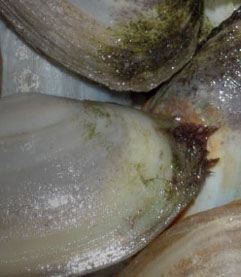 There is no reason for anyone to go hungry in this country, especially if you live by the sea.
There is no reason for anyone to go hungry in this country, especially if you live by the sea. 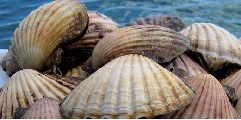 If there is one shellfish that has almost universal appeal it is scallops.
If there is one shellfish that has almost universal appeal it is scallops.